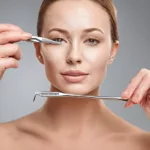21 November 2023
Experts weigh in on the benefits, safety, and efficacy of at-home LED face masks
In recent years, at-home LED face masks have gained immense popularity, with skincare enthusiasts and celebrities alike embracing these futuristic-looking devices. Promising a range of benefits, from boosting collagen production to reducing acne and inflammation, these masks come with a hefty price tag. But are they really worth the investment? We spoke to industry experts to separate fact from fiction and uncover the truth about at-home LED face masks.
What is an LED mask and how does it work?
LED masks, short for light emitting diode masks, utilize different wavelengths of light to address various skin concerns. Developed by NASA in the 1990s for astronauts’ skin therapy and wound healing, LED masks have since become popular in the skincare industry. According to Dr. Danny Guo, a dermatologist at Rejuvenation Dermatology Clinic, LED rays penetrate different depths of the skin, triggering various effects such as reducing inflammation, boosting collagen production, and minimizing acne. These non-invasive and painless treatments are safe for all skin tones and types.
What are the benefits of using an LED mask?
LED masks offer a range of benefits, depending on the type of light used. Red light helps boost collagen production and reduce redness and inflammation, making it suitable for soothing skin conditions like rosacea. Infrared and near-infrared light aid in skin healing, collagen production, and inflammation reduction. Blue light is effective for mild to moderate acne-prone skin, as it helps control oil production and minimize acne-causing bacteria. Some masks also feature green and yellow lights, which target pigmentation, increase circulation, and improve collagen production.
Is there a difference between an in-office treatment and an at-home LED mask?
While in-office LED treatments provide more intense wave lights and produce more dramatic results in a shorter amount of time, at-home LED masks can still be beneficial and effective. The results of at-home devices may be milder and less obvious, but their convenience and affordability make them a viable option for regular use. Consistency is key in achieving results, and using an at-home LED mask on a set schedule can yield positive outcomes.
Are at-home LED masks safe?
Clinical studies have shown no reported side effects from using LED masks. However, the long-term safety of these devices has not yet been determined. Individuals with photosensitized skin or sensitivity to UV rays should avoid using LED masks. It is crucial to follow the instructions carefully to prevent any damage to the eyes. Potential side effects include sleep cycle disruption and eye irritation, but when used correctly, LED masks should not cause harm. Claustrophobic individuals should exercise caution with full-face devices, and LED treatments should be avoided during pregnancy due to a lack of clinical studies.
How often do you need to use an at-home LED mask to see results?
Consistency is key when using an at-home LED mask. While each device may have specific instructions, a general guideline is a minimum of three 10 to 15-minute sessions per week, up to five or six weekly treatments. Results can typically be seen after four weeks of regular use.
What skincare should I use when doing an LED treatment?
Unless stated otherwise, start with clean, freshly washed skin before using an LED mask. Remove any makeup and follow your regular skincare routine after the LED session. Avoid using alpha hydroxy acids, beta hydroxy acids, and retinol before an LED treatment, as they can cause sensitivity in the skin.
Is an at-home LED mask worth the money?
According to experts, at-home LED light therapy can be effective and safe. While professional treatments may deliver more intense results, at-home devices can still provide benefits with regular use. The convenience and affordability of at-home masks make them a viable option for those unable to visit a dermatologist or aesthetician regularly. Ultimately, the decision to invest in an at-home LED mask depends on individual beauty budgets and commitment to regular use.
Conclusion:
At-home LED face masks offer a range of benefits, from reducing inflammation and boosting collagen production to minimizing acne. While professional treatments may provide more intense results, at-home devices can still be effective when used consistently. Safety precautions should be followed, and individuals with photosensitized skin or sensitivity to UV rays should exercise caution. With proper use and adherence to instructions, at-home LED masks can be a valuable addition to a skincare routine.



